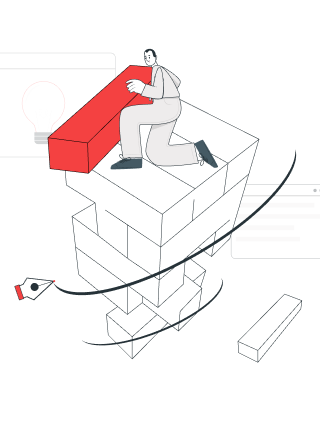In today’s digital age, designing for the best user experience (UX) is more important than ever before. With various options available, creating a design that is both functional and enjoyable to use is crucial for success. To achieve this, designers need to understand the needs, goals, and pain points of their users. UX mapping methods are an effective way to gain this understanding. They provide a framework to visualize user behaviour, pain points, and opportunities. Let us explore the different UX mapping methods available and look at how to choose the best one.
What are UX Mapping Methods?
UX mapping methods are essential instruments that allow designers and developers to delve into the intricacies of the user experience, outlining every aspect of the user’s journey, emotions, and behaviours. These visual tools come in different forms, each with a unique focus and purpose. Some of the most popular UX mapping methods include empathy maps, user personas, customer journey maps, service blueprints, and experience maps.
1. Empathy Maps
Empathy maps offer a unique way to delve deep into the user’s psyche and understand their emotion. By taking a user-centric approach, designers and developers can get a comprehensive understanding of users’ pain points, motivations, and needs. Empathy maps are typically divided into four quadrants – Says, Thinks, Does, and Feels – each representing a unique aspect of UX. This method enables the team to focus on the user’s emotional experience, allowing for a more nuanced approach to UX design.
2. User Personas
User personas are artificial personalities that embody the target audience. They serve as a potent tool to gain insights into the users’ needs, aspirations, and behaviours. User personas are created based on comprehensive user research and data analytics. Their use can guide designers and developers in making informed decisions throughout the design process. User personas typically encompass a broad range of characteristics, including demographic information, behavioural patterns, motivations, and goals.
3. Customer Journey Maps
Customer journey maps are compelling visualization tools that maps out a user’s journey. By doing so, they can identify any pain points, opportunities, and areas that can be improved in the user experience. Customer journey maps commonly encompass three distinct stages, namely, pre-purchase, purchase, and post-purchase. Within each stage, further, sub-steps are broken down and analyzed, and the user’s thoughts, emotions, and actions are methodically mapped out. This provides a thorough understanding of the user’s journey allowing informed design decisions.
4. Service Blueprints
Service blueprints are a comprehensive tool utilized to understand the processes, touchpoints, and interactions that occur between users, employees, and systems in a service-based business. They usually encompass three main layers, each with its unique elements, which include frontstage, backstage, and support processes. The frontstage layer represents the user-facing components such as the website or mobile app. On the other hand, the backstage layer showcases behind-the-scenes processes, such as order processing or customer service. The support processes layer, on the other hand, encompasses the infrastructure and technology that support the service. By mapping out these layers, designers and developers can identify any potential inefficiencies and opportunities for improvement in the service delivery process, ultimately improving the user experience.
5. Experience Maps
Experience maps are a visual representation of the user’s journey from discovery to loyalty, encompassing their interactions, emotions, and behaviours. They provide designers and developers with a holistic view of the user’s motivations, needs, and pain points. Experience maps usually consist of discovery, consideration, usage, and loyalty; each of which is broken down into smaller steps. For each step, the user’s actions, thoughts, and emotions are carefully mapped out.
How to Choose the Best UX Mapping Method?
Selecting the optimal UX mapping method is critical for any design project. And it is influenced by several factors- type of product or service being developed, the available resources, and the project goals. To help you make an informed decision, here are some crucial factors to consider when selecting a UX mapping method:
1. Consider the Goals of the Project
The first step in choosing a UX mapping method is to understand the goals of the design project. Are you trying to improve the user experience of an existing product or service? Are you designing a new product or service from scratch? Do you want to understand the user’s emotions and feelings related to the product or service? Answering these questions will help you to choose the appropriate UX mapping method.
To improve the UX of an existing product, you might need a customer journey map to identify pain points and opportunities for improvement. On the other hand, if you are designing a new product, you might need an experience map to understand the user’s goals and motivations.
2. Consider the Level of Detail Needed
Another factor to consider when choosing a UX mapping method is the level of detail needed. Some UX mapping methods, such as customer journey maps and service blueprints, provide a high-level view of the user experience. Similarly, others, such as user flows, provide a more detailed view of specific interactions.
If one is involved in designing a mobile application, it is recommended to employ a user flow to depict the specific interactions that the user might have with the application, such as tapping on buttons, swiping, and scrolling. Conversely, when designing a complex service-based business, it is advisable to use a service blueprint to delineate the various processes and interactions that occur between users, employees, and systems.
3. Involve Stakeholders in the UX Mapping Process
In order to create a holistic understanding of the user experience, involving stakeholders in the UX mapping process is a crucial step. This includes a diverse range of stakeholders such as users, designers, developers, and business stakeholders. By involving all stakeholders in the process, it is possible to gather insights from different perspectives, resulting in a more comprehensive and accurate view of the user experience.
For instance, conducting user research is a crucial step in involving users in the process. This will help to understand the needs and goals of the target audience, and identify pain points and areas for improvement. Additionally, designers and developers can provide technical input to ensure that the UX mapping method aligns with the technical requirements of the product or service. Finally, involving business stakeholders can help to ensure that the UX mapping method aligns with the overall goals and strategy of the organization.
Overall, involving stakeholders in the UX mapping process can enhance the effectiveness of the process.
In Conclusion
UX mapping is a critical aspect of user-centred design. UX mapping methods help designers understand the user experience and identify areas for improvement. When choosing a UX mapping method, it is important to consider the specific goals of the project, the type of product or service being designed, the level of detail required, and the available resources. it is also important to involve stakeholders in the process to create a more comprehensive and accurate view of the user experience. By utilizing UX mapping methods effectively, designers and developers can ensure that their products and services meet the needs and expectations of their users, resulting in a more successful and satisfying user experience. Therefore, taking the time to carefully choose and implement the appropriate UX mapping method is crucial for achieving the desired outcomes and creating a positive impact on the end-users.






